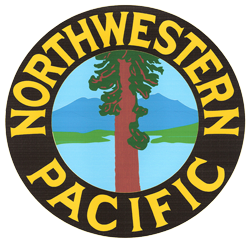From the September-October 2007 Headlight
P&SR Caboose #1 – A Diamond in the Rough
By Jeff Millerick
I’ll bet by now everybody is wondering what is going on with P&SR #1. At the last reporting the cupola had just been removed, giving #1 the appearance of still going backwards.
Well, that was the turning point. She is starting to move forward. Lloyd Butler of Oakland Pattern & Mold showed up soon after the cupola’s removal and said he would like to make us some of the difficult parts for the base at the roof level, such as the two heavy end beams sawed to the roof arch radius, the two side beams that tie the two end beams together and also carry the four short roof beams mortised and tenoned into them. With all the arches, angles and dovetail joints, these parts are difficult at best. Lloyd went right to work. Thirty days later he showed up at the work site, wood parts in hand.
All hands went to work tapping and assembling the tight-fitting pieces together. Soon the cupola roof opening was all framed in, new and structurally sounder than it ever was. Two more steel 5/16 x 2 roof-beams rolled the hard way are also bolted to the cupola’s arched end beams and then through the outside walls at the ends, tying the outside walls together while giving support to the frail cupola end beam tails at the outer walls. The outer tails of these two beams are only 2-1/2″ x 2-1/2″ of wood. These four ends are really what held the old cupola up for 100 years! How, I don’t know! Lloyd says he would like to take the cupola to his shop in Oakland and complete the rest of the more difficult parts. Yes, you can, Lloyd! Thank you for your hard work.
While the cupola work is going on the new steel center frame beam is being slid into place. Loren Williams, John Schubert, Gus Campagna, Mike Manson, Skip Ruckert and I pulled on ropes, moving the 400-500 pound beam into place, at which time a floor jack was set under the beam, a little off-center. By jacking a little off-center, the light end went up quickly and was maneuvered up against the car’s bottom transverse cross members to be blocked tight. The jack was then moved to the other end, bringing it up slowly, blocking as it was raised tight to the transverse beams.
Oh, no! Looking at the holes for the two needle beams to pass through – they are too low. How could this have happened? Well, end of the work day, time to go home and we’ll worry about it later. After shaking my head in despair for a week, the light came on. We still need to notch the floor cross beams up 2-1/2″ to the base of the mortise and tenons, giving the tenons support at the center beams. Next word day the notches were made and up went the beam to a perfect fit, giving the tired old wood beams a rest. The new steel center beam will soon be welded to the coupler support beams, just behind the bolsters, tying #1 together from end to end with steel – straight and strong. The needle beams were next slid into place through the center beam holes. They are made of some recycled tough old fir, much tougher than the originals. Boy, do they look good – a perfect fit!
A week later at the Awards Dinner barbeque, Bruce Evans said Roots and he had something for #1. He soon appeared with a cardboard box; inside were four queen posts for our new truss rods. Thanks, Bruce and Roots. We know you worked hard removing them from your parts car. One week later they were painted and ready to install. The turnbuckles, truss rods and square-headed bolts were on site. Within hours #1 has her truss rods again, after 50 years!
Things are going well. Gus, Charlie and Skip have been working on the outside corners, replacing with treated wood the lower deteriorated corner wood. Mike, John Schwirtz and Don Brewer keep pecking away at the paint stripping, between other tasks. Removing multiple layers of paint without damaging the wood has proven to be no small task, requiring infinite patience and there is still more to go.
We have acquired a pair of brake hand wheels as shown on the original SP plans (from Ebay and from a flea market). They have been straightened along with the end rails, ladders and grip rails, ready for the sandblaster.
Basically, all running hardware has been located, except for those elusive Janney couplers. They were relatively common so they are out there somewhere. Please check your iron piles or the piles of the short line railroad you may travel. “Janney” is cast into the top of the knuckle.
